Shep Hyken's Blog, page 87
April 6, 2021
Amazing Business Radio: Jeff Toister
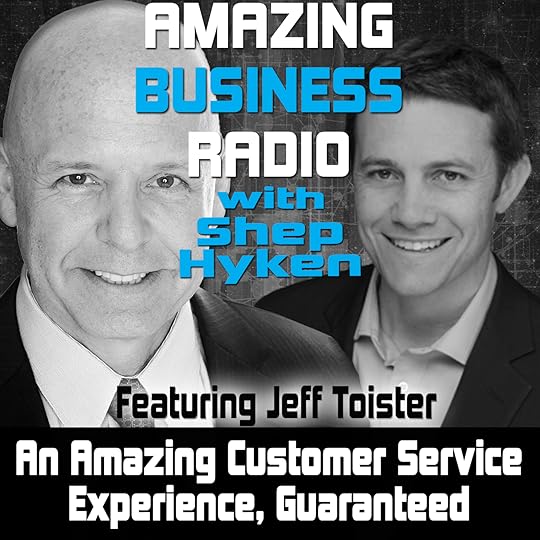 An Amazing Customer Experience, Guaranteed How to Get Customers to Gain Trust and Confidence in Your Brand
An Amazing Customer Experience, Guaranteed How to Get Customers to Gain Trust and Confidence in Your BrandShep Hyken interviews Jeff Toister, a customer service author, consultant, and trainer. They discuss how making or breaking promises affects the customer experience.








Top Takeaways:
Broken promises to your customers can be either implicit or explicit depending on the situation or marketing strategy. There are lots of reasons why some promises are not kept. Mistakes will happen or there will be miscommunication throughout management, or sometimes people become busy and a little forgetful. Many companies struggle to provide a consistent customer experience and inconsistent experiences create distrust and cause customer churn. Shep’s definition of amazement is simply being better than average all the time. Consistently amazing your customers is key in earning their trust and confidence in your business. Advertising is making a promise to your customers. It sets the expectations for your customers. A customer doesn’t buy a product or service. They buy a solution. For example, you’ll buy a soda because you’re thirsty. You buy a drill to make a hole. Businesses can use the framework of a guarantee to provide a more consistent experience and there are three elements to an experience guarantee: 1) Promise to solve a customer’s problem. 2) Act to solve it. 3) Recover from any service failures. Think about what the real question is, behind the question your customers actually give you. Be aware of the solution your customers are searching for.Quotes:
“Advertising helps set the customer’s expectation on the promises that brands are willing to deliver.”
“Brands need to take deliberate actions to ensure they’re keeping their promises to their customers.”
“The most convenient brands are able to anticipate an issue that they’re already ready to solve.”
About:
Jeff Toister is an author, consultant, and trainer who helps companies develop customer-focused cultures. He’s written four books including The Guaranteed Customer Experience. Thousands of customer service professionals around the world subscribe to Jeff’s Customer Service Tip of the Week email.
Shep Hyken is a customer service and experience expert, New York Times bestselling author, award-winning keynote speaker, and your host of Amazing Business Radio.
This episode of Amazing Business Radio with Shep Hyken answers the following questions … and more:
How to build trust with your customers? How to deliver an amazing customer experience? How to create a brand promise? What is a broken promise? How to create customer loyalty?The post Amazing Business Radio: Jeff Toister appeared first on Shep Hyken.
April 5, 2021
5 Top Customer Service Articles For the Week of April 5, 2021
Each week I read a number of customer service and customer experience articles from various resources. Here are my top five picks from last week. I have added my comment about each article and would like to hear what you think too.
Balancing Humanization and Digitization: 3 Key Customer Service Trends by Jordy Leiser
(TotalRetail) Customer service will continue to be a key differentiator in 2021 and beyond, and it’s therefore vital that brands meet the rising expectations of their customers. Here are three customer service trends brands should prepare for in 2021.
My Comment: This is an interesting article written by Jordy Leiser, the founder of Stella Connect. I’ve been preaching there needs to be a balance between the digital customer service experience and the human one. Here are the trends we need to know and understand, especially if you plan to implement self-service solutions for your customers to use. Some of the stats surprise me (and might surprise you), but they make his case.
Customer experience in 2025: here’s where we’re heading by Chris McGugan
(ClickZ) By 2025, it’s likely that nine dollars of every $10 will be spent on the digital experience versus phone/voice. Oracle Service’s SVP and GM, Chris McGugan predicts customer experience for the years to come.
My Comment: A perfect follow-up to Jordy Leiser’s article (our first in the Top Five roundup) is this article that predicts that by 2025 everything will be automated. I’m betting against it. That’s just too soon. Had the author said 2035, I might buy into this. Still, I enjoyed a glimpse into the future.
Help Your Business Stand Out in 2021 With These 6 Tips by Angela Hausman
(Market Maven) Here are a few tips to help your business stand out in 2021.
My Comment: Here is an excellent list of six ideas to create a better customer experience. My favorite was the second one, which focuses on giving away valuable content for free. If you want to build a trusted following with a community of customers and prospects, provide easy-to-access value that gets them coming back for more. And that’s just one of the five.
Building Trust and Credibility for Your Business: Tips to Avoid Mistakes by Angela Hausman, PhD
(Business2Community) Read on to learn more about how you can use relatively simple tactics to build trust and credibility for your business.
My Comment: Trust is a very important asset for a company. My friend David Horsager, author of the recently published book The Trusted Leader, says (backed with research) that trust is an organization’s most important asset. This article shares some tips that apply to most businesses. They will be excellent conversation starters to ensure that your organization is delivering a trustworthy experience.
12 Customer Experience Stats Show Why Resolving Channel Silos Is Crucial Today by Medallia
(CMSWire) Here are 12 good customer experiences stats featured in Medallia’s “Contact Center and Digital, Better Together” eBook that illustrate the urgency of why brands need to close the gap between their digital and traditional customer service channels to improve both overall and digital customer experiences.
My Comment: This final article for this week’s list is a bit technical, but if you are in the customer support and contact center world, it is an essential read. Here are the stats from recent research that give insights into what customers are experiencing with the multiple channels they are using. Some companies are taking advantage of this, while others are going to have to play catch-up.
BONUSThe Top Customer Experience Podcasts (Updated March ’21) by Adam Ramshaw
(Genroe) To be featured on this list the podcast must be in active, regular production. Podcasts which appear to have ceased production or are only published occasionally have been excluded.
My Comment: If you listen to podcasts on customer service and customer experience, then you’ll want to read this article. Here are the top-rated podcasts in the industry. Start listening today!
Shep Hyken is a customer service expert, professional speaker and New York Times bestselling business author. For information on The Customer Focus customer service training programs go to www.TheCustomerFocus.com. Follow on Twitter: @Hyken
customer service training programs go to www.TheCustomerFocus.com. Follow on Twitter: @Hyken
The post 5 Top Customer Service Articles For the Week of April 5, 2021 appeared first on Shep Hyken.
April 2, 2021
Guest Post: The 4 Most Common Misconceptions About Customer Service
This week we feature an article by Hannah McCabe, Director of Demand at Stella Connect by Medallia. She shares common misconceptions about customer service and offers ways to fight them in order to provide great customer experiences.
Delivering excellent customer service means understanding the ins and outs of your customer personas, your competitive landscape, your business, and – of course – your own organization and industry.
But as is the case with other organizations, customer service has its fair share of myths about what customers want, which metrics to track, and how to perform the responsibilities of a front-line agent.
Keep reading to dive into four common misconceptions about customer service, and how to combat them to offer better customer experiences.
The 4 Most Common Misconceptions About Customer ServiceMisconception #1: Every angry customer just wants a discount.
When it comes to angry customers, you may think that someone is only causing a commotion to save a quick buck, but you would be wrong.
Research from the Journal of Marketing shows that offering angry customers a price-based solution (like a discount) actually negatively affects their view of your brand and their likelihood to continue supporting your business.
First, it devalues your product or service to them by making them believe it’s not worth the full price. Second, it shows them that you aren’t really interested in understanding their needs, and are simply offering the promotion as an easy way out.
Customers want to be heard by your business and know that you take their frustrations seriously.
When communicating with angry customers, don’t let this misconception cloud how you approach the situation. Doing so can lead to even greater frustration from your customer and affect your ability to resolve their issue.
Misconception #2: Customers only want self-service options.
In the U.S. alone, e-commerce now accounts for 16.1% of all sales. That number is up from 11.8% in the first quarter of 2020, and expected to continue to rise throughout 2021.
For many businesses, meeting increased online demand means a pivot to more automated ways of providing support, like chatbots, to free up agents to handle more complex issues.
However, according to Stella Connect’s Customer Service Trends for 2021 report, 80% of survey respondents prefer to talk to a real support agent, versus figuring out the issue with self-service options.
This statistic points to the fact that modern customers are looking for humanized customer support that understands their pain points and can give them personalized responses to their needs.
The data also has implications for future CX tech stack investments. When creating your customer service strategy, it’s important to continue to invest in new technologies and platforms, but don’t overlook the value of optimizing your current channels.
Misconception #3: Speed is the most important customer service metric.
The first customer service metrics that come to mind are often around speed, like Average Handle Time (AHT). Speed is typically equated with efficiency, the core belief being that the faster you get through your ticket queue, the better your performance is.
But customers don’t want to feel like another ticket in the queue.
Instead of using speed as a measure of success, brands should focus on an array of customer satisfaction metrics.
Metrics like Customer Effort Score (CES), First Contact Resolution (FCR), and Customer Satisfaction Score (CSAT) look at how completely an issue is resolved and, ultimately, how your customers feel about the service they received.
This shift sets your brand up for success because it takes the onus off the agent to close tickets as quickly as possible, letting them focus on providing valuable service, regardless of how long they may spend with a single customer.
Misconception #4: You can’t save your relationship with a customer after a negative experience.
Even with the perfect strategies in place, there will be customers who feel dissatisfied enough to leave negative feedback about your business or your agents. It’s how you handle that feedback that makes a difference.
In our survey, 61% of consumers reported that they would be willing to do business with a brand again after a negative experience if the brand was able to solve their problem and turn their experience into a positive one.
Knowing this, having a service recovery strategy in place is crucial for businesses today.
Service recovery is the idea that negative customer feedback is a salvageable touchpoint in a customer journey.
Customers appreciate being heard and knowing their feedback doesn’t disappear into the void.
Service recovery also gives you another valuable metric alongside customer satisfaction that’s more agent-based, and more applicable to the health of your entire CX organization.
Combating Common Customer Service Misconceptions
Buying into misconceptions can not only negatively impact how you approach your day-to-day responsibilities as a customer service professional, but can ultimately harm how your customers see your brand.
After all, front-line agents are the face of their brand to customers. As such, it’s important that they can approach each new customer inquiry without preconceived notions of how to handle the interaction.
Hannah McCabe is the Director of Demand at Stella Connect by Medallia. She is passionate about sustainability, growth (both personal & professional), the Oxford comma, and lipstick.
F
 or more articles from Shep Hyken and his guest contributors go to customerserviceblog.com.
or more articles from Shep Hyken and his guest contributors go to customerserviceblog.com.
Read Shep’s latest Forbes article: Leaders, Trust Is Your Most Important Asset
The post Guest Post: The 4 Most Common Misconceptions About Customer Service appeared first on Shep Hyken.
March 31, 2021
Get to Know Your Customer Day
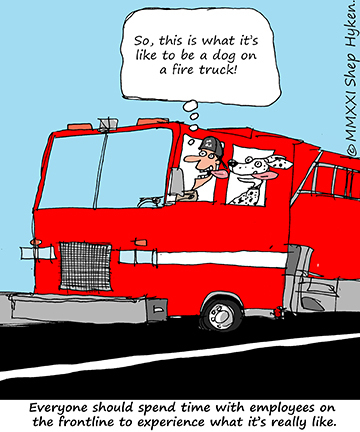 It’s been years since I’ve written about Get to Know Your Customer Day. Recently, however, I’ve been asked what it’s all about, so I thought it was time to bring it up again. This time I want to share a few tips on what to do for these special days that are observed throughout the year.
It’s been years since I’ve written about Get to Know Your Customer Day. Recently, however, I’ve been asked what it’s all about, so I thought it was time to bring it up again. This time I want to share a few tips on what to do for these special days that are observed throughout the year.
Get to Know Your Customer Day happens four times a year, on the third Thursday of each quarter, so they are held in January, April, July, and October. Here’s something most people don’t know … I actually invented the holiday, if you want to call it that. That’s right! I was looking to create some buzz about connecting with customers, and I submitted the idea to Chase’s Calendar of Events. Next thing you know, it’s published and has become a real holiday in the business world! Pretty cool!
Keep this in mind. While Get to Know Your Customer Day happens just four times a year, that doesn’t mean you shouldn’t always want to know more about your customers. It should be an all-the-time effort. Still, these four days give you the opportunity to renew the enthusiasm for the idea of getting to know your customers even better. So, here are three of my favorite ways to get to know your customer.
1. Focus on Feedback. Create a survey to learn what your customers want and expect from you. Keep it short and simple – even just two or three questions. The shorter the survey, the higher the percentage of response you’ll get.
2. Conduct a Focus Group. This brings your customers in for a face-to-face discussion, giving you real feedback and the chance to learn your customers’ opinions of your most current offerings. By the way, if you can’t meet in person, you can always do a virtual focus group. Send everyone a voucher for dinner or lunch at a favorite restaurant in their area and have them join you for dinner and a conversation that’s all about them!
3. Spend a Day on the Front Line. This is one of my favorites. If you’re not working directly with customers, one of the best ways to learn what’s really happening on the front line is to spend a shift with a customer support agent or go out for some sales calls. This is especially important for the leadership and management of a company, as they are often far removed from the day-to-day customer interactions.
There you have it, three ways you can get to know your customers even better. Obviously, getting to know what your customers want, need, and expect is just half of it. Once you have that information, do something with it!
Shep Hyken is a customer service expert, keynote speaker, and New York Times, bestselling business author. For information, contact 314-692-2200 or www.hyken.com. For information on The Customer Focus customer service training programs, go to www.thecustomerfocus.com. Follow on Twitter: @Hyken
customer service training programs, go to www.thecustomerfocus.com. Follow on Twitter: @Hyken
(Copyright © MMXXI, Shep Hyken)
The post Get to Know Your Customer Day appeared first on Shep Hyken.
March 30, 2021
Amazing Business Radio: Adele Gutman Milne
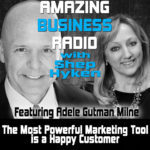 The Most Powerful Marketing Tool is a Happy CustomerHow to create a 5-Star Experience for Your Customers Every Time
The Most Powerful Marketing Tool is a Happy CustomerHow to create a 5-Star Experience for Your Customers Every TimeShep Hyken interviews Adele Gutman Milne, Culture and Guest Experience Expert. They discuss tips on how to achieve 5-Star ratings from the hospitality perspective.







 Top Takeaways:While it is an age-old adage that word of mouth is the most powerful advertising, many companies have not yet embraced this wonderful opportunity.Many hoteliers (and businesses in general) spend a fortune on advertising and little to no investment of time or energy in inspiring empowering their team to top performance.Teach GM’s and department heads to start inspiring and empowering. Our teams are full of talent that we can use if we invite them to collaborate.Many business owners like the thought of having consistent 5-Star reviews but don’t know where to begin.Every interaction you have with external customers, as well as internal customers, should end with everyone feeling better than when they came to you.When interviewing a potential employee, read your company’s mission statement aloud and watch the candidate’s reaction to test whether that candidate truly aligns with your company culture.Adele’s six-step process for achieving 5-star reviews:Write down your ultimate review, with details about what makes your experience so special.Share your business mission and vision with your team.Shoot for the stars. If you shoot for 80% guest (customer) satisfaction, you’ll never know the joy of 96%.Use each critical review as a trigger for continuous improvement.Hire happy people pleasers and give them the tools, training, support, and freedom from fear that they need to be successful in making guests happy.Talk about kindness and compassion every day.Quotes:
Top Takeaways:While it is an age-old adage that word of mouth is the most powerful advertising, many companies have not yet embraced this wonderful opportunity.Many hoteliers (and businesses in general) spend a fortune on advertising and little to no investment of time or energy in inspiring empowering their team to top performance.Teach GM’s and department heads to start inspiring and empowering. Our teams are full of talent that we can use if we invite them to collaborate.Many business owners like the thought of having consistent 5-Star reviews but don’t know where to begin.Every interaction you have with external customers, as well as internal customers, should end with everyone feeling better than when they came to you.When interviewing a potential employee, read your company’s mission statement aloud and watch the candidate’s reaction to test whether that candidate truly aligns with your company culture.Adele’s six-step process for achieving 5-star reviews:Write down your ultimate review, with details about what makes your experience so special.Share your business mission and vision with your team.Shoot for the stars. If you shoot for 80% guest (customer) satisfaction, you’ll never know the joy of 96%.Use each critical review as a trigger for continuous improvement.Hire happy people pleasers and give them the tools, training, support, and freedom from fear that they need to be successful in making guests happy.Talk about kindness and compassion every day.Quotes:“Remember to C.A.R.E.: Every customer that you talk to should feel Cared for, Appreciated, and Respected at Every encounter.”
“Imagine what you would like customers to say about you and then strive to be that business that gets those kinds of reviews. Start with the end in mind.”
“Constantly remind your team how important kindness and compassion are to getting great reviews and making great relationships, because attitude is everything.”
“The mindset that the way you’ve always done things is still working, prevents you from opportunities to learn and grow from feedback given to you by your customers.”
About:Adele Gutman Milne is a culture and guest experience expert and host of the Hospitality Reputation Marketing Podcast: Get Great Reviews. Adele also has been named one of the Top 25 Extraordinary Minds by HSMAI along with numerous other awards for her leadership in Hospitality Reputation Marketing.
Shep Hyken is a customer service and experience expert, New York Times bestselling author, award-winning keynote speaker, and your host of Amazing Business Radio.
This episode of Amazing Business Radio with Shep Hyken answers the following questions … and more:
How to get 5-star reviews?How to create an amazing customer experience?How to get good ratings from your customers?How to empower your employees?How to hire the right employee in customer service?The post Amazing Business Radio: Adele Gutman Milne appeared first on Shep Hyken.
March 29, 2021
5 Top Customer Service Articles For the Week of March 29, 2021
Each week I read a number of customer service and customer experience articles from various resources. Here are my top five picks from last week. I have added my comment about each article and would like to hear what you think too.
How Disney Knocks it Out of The Park With an Excellent Customer Experience (And How You Can Too) by Ellen Christenberry
(Sharpen) Here are some of the ways Disney knocks it out of the park – and then some – in providing excellent customer service. Plus, we give you some practical tips on how you can model your CX after Disney.
My Comment: I never miss the chance to learn from an iconic brand, and in this case it’s Disney. Our friends at Sharpen have an excellent article that shares five lessons on how you can model your CX after Disney. I especially appreciate the first one, which is to value your employees first.
Humans and Robots in Retail: It’s Not Us vs. Them by Justin Sears
(TotalRetail) Here are a few specific ways that automation is making work better for digital merchandisers, allowing them to improve the customer experience (CX) while enjoying a far better employee experience (EX).
My Comment: Many of my clients ask me about the idea that automation will replace humans. There is no doubt that automation is playing a key role in the customer experience, but it is far from eliminating the need for human-to-human interaction. I enjoyed this article on the struggle between humans and robots in retail. They can (and will continue) to coexist.
Deep Dive: How Sweetwater Builds Software and Personalized Experiences by Jamie Grill-Goodman
(RIS) RIS sits down with Sweetwater’s CIO Jason Johnson to dive into how the instrument retailer develops in-house tech to invoke its unique customer experience.
My Comment: Sweetwater may not be a brand as recognizable as Disney unless you’re in the music industry. If you’ve ever bought anything from them, you’ve experienced an excellent experience. They could even be considered the Disney of their industry. For this article, as the title suggests, we’re going to take a “Deep Dive” into the technical side of Sweetwater and how they build personalized experiences, which leads to loyalty.
In The Rush To Go All-Digital, Prioritize Employee Experiences by Brian Solis
(Forbes) In a post-COVID economy, progressive companies around the world are accelerating digital investments in customer experience (CX) optimization, enhancement, and unification.
My Comment: The past year has changed how many businesses operate. When the pandemic began, they were forced to use more digital options to support customers. With all the effort focused on customers, don’t forget about employees. The transition to more digital experiences aren’t just for your customers, but also for employees. The line that drew me in was this: “Designing for EX (Employee Experience) is the next competitive advantage.”
Consumers set a high customer service bar, but not every brand can deliver by Maria Monteros
(Retail Dive) The customer may not always be right, but experts say there’s a price to pay when brands don’t take care of them.
My Comment: Our customers are smarter than ever. They know what a good experience is, and they expect to get it. Still, some brands struggle to deliver, and there is a price to pay for their missteps.
Shep Hyken is a customer service expert, professional speaker and New York Times bestselling business author. For information on The Customer Focus customer service training programs go to www.TheCustomerFocus.com. Follow on Twitter: @Hyken
customer service training programs go to www.TheCustomerFocus.com. Follow on Twitter: @Hyken
The post 5 Top Customer Service Articles For the Week of March 29, 2021 appeared first on Shep Hyken.
March 26, 2021
Guest Post: How to Make a Company Culture Video That Wins Your Customers’ Hearts
This week we feature an article from Victor Blasco, CEO of Yum Yum Videos. He writes about how creating a company culture video helps your business to build stronger relationships with your customers.
When we think about the advantages that small businesses hold against big companies, the first thing that comes to mind is the close relationship with their customers. Clients prefer buying from someone they are familiar with, especially when it’s run by people they know and whose values they empathize with.
Larger companies tend to lack such a close connection with their customers. People see them as a mere building with a sign on the door or a colorful website.
If that’s how your audience perceives your business, you might have a big problem – as this may prevent you from closing more sales. But don’t despair: there’s a light at the end of the tunnel; a film light, to be more precise, and a video production team right with it!
Yes. A culture video may be the solution you are looking for – helping you bridge the emotional distance between you and your audience and allowing you to introduce your team and the values they share.
And today, we’ll tell you how to use them to win your customers’ hearts! Ready to begin?

To produce any company story video worth watching, you first need to define your company values.
Yes, I know: you probably took care of that on day one. However, it’s vital you take a moment to analyze if those concepts have come to life in your business’s daily routine.
You see, everything that appears in your video should correspond to reality. And if, in reality, your company’s philosophy isn’t the same as on paper, then it may be time to get back on track or redefine what your business is really about.
Pick a Topic that Speaks to Your ValuesMany companies stay away from culture videos because they don’t feel they have something worth showing. Sure, it’s easy to portray your appealing working environment when you are such a cool company as Apple or Google. But, what about those that are more like Dunder Mifflin?
Well, even in that case, there’s always something worth sharing.
It could be anything – literally, anything. The right video production team can make a heartwarming story of your veteran-but-tireless secretary or a beautiful animation of the office’s goldfish.
For example, you can cover the company’s policies that stand out from the rest, like a special program for working mothers or young interns. Or you could film a particular event, like a team-building activity.
As long as the topic reflects your company’s real values, anything is possible.
.hytPlayerWrap{display: inline-block; position: relative;}.hytPlayerWrap.ended::after{content:""; position: absolute; top: 0; left: 0; bottom: 0; right: 0; cursor: pointer; background-color: black; background-repeat: no-repeat; background-position: center; background-size: 64px 64px; background-image: url(data:image/svg+xml;utf8;base64,PHN2ZyB4bWxucz0iaHR0cDovL3d3dy53My5vcmcvMjAwMC9zdmciIHdpZHRoPSIxMjgiIGhlaWdodD0iMTI4IiB2aWV3Qm94PSIwIDAgNTEwIDUxMCI+PHBhdGggZD0iTTI1NSAxMDJWMEwxMjcuNSAxMjcuNSAyNTUgMjU1VjE1M2M4NC4xNSAwIDE1MyA2OC44NSAxNTMgMTUzcy02OC44NSAxNTMtMTUzIDE1My0xNTMtNjguODUtMTUzLTE1M0g1MWMwIDExMi4yIDkxLjggMjA0IDIwNCAyMDRzMjA0LTkxLjggMjA0LTIwNC05MS44LTIwNC0yMDQtMjA0eiIgZmlsbD0iI0ZGRiIvPjwvc3ZnPg==);}.hytPlayerWrap.paused::after{content:""; position: absolute; top: 70px; left: 0; bottom: 50px; right: 0; cursor: pointer; background-color: black; background-repeat: no-repeat; background-position: center; background-size: 40px 40px; background-image: url(data:image/svg+xml;utf8;base64,PHN2ZyB4bWxucz0iaHR0cDovL3d3dy53My5vcmcvMjAwMC9zdmciIHZlcnNpb249IjEiIHdpZHRoPSIxNzA2LjY2NyIgaGVpZ2h0PSIxNzA2LjY2NyIgdmlld0JveD0iMCAwIDEyODAgMTI4MCI+PHBhdGggZD0iTTE1Ny42MzUgMi45ODRMMTI2MC45NzkgNjQwIDE1Ny42MzUgMTI3Ny4wMTZ6IiBmaWxsPSIjZmZmIi8+PC9zdmc+);}"use strict"; document.addEventListener('DOMContentLoaded', function(){if (window.hideYTActivated) return; let onYouTubeIframeAPIReadyCallbacks=[]; for (let playerWrap of document.querySelectorAll(".hytPlayerWrap")){let playerFrame=playerWrap.querySelector("iframe"); let tag=document.createElement('script'); tag.src="https://www.youtube.com/iframe_api&qu... let firstScriptTag=document.getElementsByTagName('script')[0]; firstScriptTag.parentNode.insertBefore(tag, firstScriptTag); let onPlayerStateChange=function(event){if (event.data==YT.PlayerState.ENDED){playerWrap.classList.add("ended");}else if (event.data==YT.PlayerState.PAUSED){playerWrap.classList.add("paused");}else if (event.data==YT.PlayerState.PLAYING){playerWrap.classList.remove("ended"); playerWrap.classList.remove("paused");}}; let player; onYouTubeIframeAPIReadyCallbacks.push(function(){player=new YT.Player(playerFrame,{events:{'onStateChange': onPlayerStateChange}});}); playerWrap.addEventListener("click", function(){let playerState=player.getPlayerState(); if (playerState==YT.PlayerState.ENDED){player.seekTo(0);}else if (playerState==YT.PlayerState.PAUSED){player.playVideo();}});}window.onYouTubeIframeAPIReady=function(){for (let callback of onYouTubeIframeAPIReadyCallbacks){callback();}}; window.hideYTActivated=true;});
Focus on One or Two Core ValuesYour video shouldn’t go on and on forever – I hate to break it to you, but people are not that interested in your company’s culture. So, it’s better if you keep your video under the 3-minute mark.
This time limit doesn’t give you enough room to ramble on about every little thing that goes on inside your company. And even if it did, it wouldn’t be advisable for you to do so.
If you touch more than one topic, you can end up with an intricate piece that the viewer finds hard to follow. Equally important, you wouldn’t be able to dig into each subject enough! You’d rather address one single value in-depth than several topics shallowly.
Choose HonestyCulture videos are meant to generate empathy and trust to bring you closer to your audience. But if there’s one thing that can defeat this purpose, that is lying. That’s one sure way of being locked out of your audiences’ hearts.
Your audience can perfectly distinguish a real interview from an actor reading scripted answers. Dirty tricks like that one are bound to backfire, not to mention they are not easy to pull out.
It may sound simpler to hire professional actors than to make some of your employees beat their camera fright, but it isn’t. The hiring process involves casting the right actors, rehearsing the script, and paying for their services. Presenting your actual staff is faster, cheaper, and gives the video an authentic feel that viewers love.
.hytPlayerWrap{display: inline-block; position: relative;}.hytPlayerWrap.ended::after{content:""; position: absolute; top: 0; left: 0; bottom: 0; right: 0; cursor: pointer; background-color: black; background-repeat: no-repeat; background-position: center; background-size: 64px 64px; background-image: url(data:image/svg+xml;utf8;base64,PHN2ZyB4bWxucz0iaHR0cDovL3d3dy53My5vcmcvMjAwMC9zdmciIHdpZHRoPSIxMjgiIGhlaWdodD0iMTI4IiB2aWV3Qm94PSIwIDAgNTEwIDUxMCI+PHBhdGggZD0iTTI1NSAxMDJWMEwxMjcuNSAxMjcuNSAyNTUgMjU1VjE1M2M4NC4xNSAwIDE1MyA2OC44NSAxNTMgMTUzcy02OC44NSAxNTMtMTUzIDE1My0xNTMtNjguODUtMTUzLTE1M0g1MWMwIDExMi4yIDkxLjggMjA0IDIwNCAyMDRzMjA0LTkxLjggMjA0LTIwNC05MS44LTIwNC0yMDQtMjA0eiIgZmlsbD0iI0ZGRiIvPjwvc3ZnPg==);}.hytPlayerWrap.paused::after{content:""; position: absolute; top: 70px; left: 0; bottom: 50px; right: 0; cursor: pointer; background-color: black; background-repeat: no-repeat; background-position: center; background-size: 40px 40px; background-image: url(data:image/svg+xml;utf8;base64,PHN2ZyB4bWxucz0iaHR0cDovL3d3dy53My5vcmcvMjAwMC9zdmciIHZlcnNpb249IjEiIHdpZHRoPSIxNzA2LjY2NyIgaGVpZ2h0PSIxNzA2LjY2NyIgdmlld0JveD0iMCAwIDEyODAgMTI4MCI+PHBhdGggZD0iTTE1Ny42MzUgMi45ODRMMTI2MC45NzkgNjQwIDE1Ny42MzUgMTI3Ny4wMTZ6IiBmaWxsPSIjZmZmIi8+PC9zdmc+);}"use strict"; document.addEventListener('DOMContentLoaded', function(){if (window.hideYTActivated) return; let onYouTubeIframeAPIReadyCallbacks=[]; for (let playerWrap of document.querySelectorAll(".hytPlayerWrap")){let playerFrame=playerWrap.querySelector("iframe"); let tag=document.createElement('script'); tag.src="https://www.youtube.com/iframe_api&qu... let firstScriptTag=document.getElementsByTagName('script')[0]; firstScriptTag.parentNode.insertBefore(tag, firstScriptTag); let onPlayerStateChange=function(event){if (event.data==YT.PlayerState.ENDED){playerWrap.classList.add("ended");}else if (event.data==YT.PlayerState.PAUSED){playerWrap.classList.add("paused");}else if (event.data==YT.PlayerState.PLAYING){playerWrap.classList.remove("ended"); playerWrap.classList.remove("paused");}}; let player; onYouTubeIframeAPIReadyCallbacks.push(function(){player=new YT.Player(playerFrame,{events:{'onStateChange': onPlayerStateChange}});}); playerWrap.addEventListener("click", function(){let playerState=player.getPlayerState(); if (playerState==YT.PlayerState.ENDED){player.seekTo(0);}else if (playerState==YT.PlayerState.PAUSED){player.playVideo();}});}window.onYouTubeIframeAPIReady=function(){for (let callback of onYouTubeIframeAPIReadyCallbacks){callback();}}; window.hideYTActivated=true;});
Plan Your QuestionsAfter reading so many praises about honesty, it may surprise you that I’m about to talk about your video’s script.
Don’t get me wrong: this is about making a sincere script. One that respects your employees’ own words, but that also results in the culture video you envision.
The idea here is to write the interview questions beforehand and send them to the interviewees – your staff – before the filming day. Give them a day or two to prepare their answers and even rehearse them, if that makes them feel more comfortable. Do advise them, though, not to learn their answers by heart since that may affect the interview’s authentic feel.
Make Your Interviewees Feel at EaseLet’s face it: only a few privileged people were born with the natural charisma to be in front of a camera. The rest of us mortals can’t help to get a shaky voice during a culture video interview. As an interviewer, you should create a kind and calm environment and get your staff to relax.
You can start by making the interview as conversational as possible. In fact, start a conversation even before the camera is on. Ask the staff about their lives, interests, or how pleasant the weather is. Only when they are comfortable enough, turn on the camera and start filming.
Avoid making discouraging gestures behind the camera or interrupting them because you dislike what they are saying. Let them finish and, if necessary, ask them to answer the question again.
The TakeawayIt’s not easy to connect emotionally with your customers from behind a screen or across the phone. But company story videos can help you bridge this distance and give your audience solid reasons to empathize with your business and its values.
Presenting the people that make your products and services possible can go a long way in the customers’ eyes. They can start seeing your company from a more human perspective instead of perceiving it as a greedy institution.
At the end of the day, you can offer more economical or better-quality products or services than your competition. Still, if your audience empathizes better with their values instead of yours, the game is over.
Victor Blasco is an audiovisual designer, video marketing expert, and founder/CEO of the explainer video production company Yum Yum Videos. Besides running the business, he’s a lifelong student of Chinese philosophy and a passionate geek for all things sci-fi.
F
 or more articles from Shep Hyken and his guest contributors go to customerserviceblog.com.
or more articles from Shep Hyken and his guest contributors go to customerserviceblog.com.
Read Shep’s latest Forbes article: Online Access is Key to Inclusion – Make Your Website More Welcoming
The post Guest Post: How to Make a Company Culture Video That Wins Your Customers’ Hearts appeared first on Shep Hyken.
March 24, 2021
The Most Important Measurement In Business
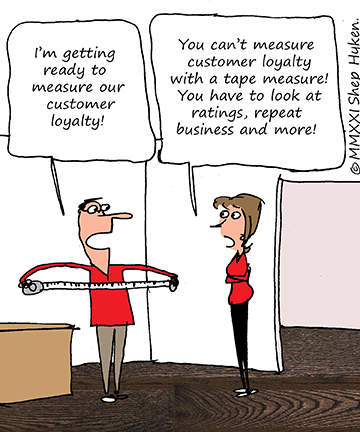 This is the first of a number of lessons I’ll be sharing from my newest book, I’ll Be Back: How to Get Customers to Come Back Again and Again. A few years back I wrote about the idea of measuring customer satisfaction versus customer behavior. We’re revisiting that topic with a fresh point of view.
This is the first of a number of lessons I’ll be sharing from my newest book, I’ll Be Back: How to Get Customers to Come Back Again and Again. A few years back I wrote about the idea of measuring customer satisfaction versus customer behavior. We’re revisiting that topic with a fresh point of view.
Today’s lesson is about the exciting topic of measurement and data. Okay, maybe not that exciting, but how about very important? You know it is! Business management guru Peter Drucker said, “You can’t manage what you don’t measure.”
So, what should we be measuring? What’s the best metric? Why do our customers come back? There are a number of ways organizations measure customer satisfaction. By the way, I don’t like that word, satisfaction. The word satisfactory implies everything is okay, average, or fine. If you asked someone to rate you as either poor, satisfactory, or excellent, you can see that satisfactory is in the middle. Again, just average. But, back to the point. Call it customer satisfaction, customer happiness, or anything you want. The important idea to remember is that we’re looking at ratings.
As an example, two very popular measurements are NPS (Net Promoter Score) and CSAT (Customer Satisfaction). Both give you an idea of how happy the customer is. But, you need to know more. When you ask marketing and customer service experts what they monitor, you’ll likely hear about similar satisfaction or happiness measurements. You’ll also hear them talk about sales numbers, profit, revenue, and other indications that the company is doing well – or not so well.
But another measurement I suggest companies pay close attention to, in addition to those just mentioned, is this one: Does the customer come back?
That’s not a rating. That’s behavior! Big difference. Your customers can rate you five out of five stars and give you glowing reviews. But what if they don’t come back? The ratings and reviews were nice, but the opportunity to do more business vanishes if they don’t return.
It’s important to know how customers feel about the experience they just had. We should always be looking at those experiences and finding ways to make them better. Feedback and ratings will help drive that effort. But in the end, knowing what percentage of customers come back, how often they come back, and how much they buy when they do come back, is a metric to pay close attention to.
If getting your customers to come back, again and again, is important to you, and you know it is, you’ll love the book. Just go to www.IllBeBackBook.com.
Shep Hyken is a customer service expert, keynote speaker, and New York Times, bestselling business author. For information, contact 314-692-2200 or www.hyken.com. For information on The Customer Focus customer service training programs, go to www.thecustomerfocus.com. Follow on Twitter: @Hyken
customer service training programs, go to www.thecustomerfocus.com. Follow on Twitter: @Hyken
(Copyright © MMXXI, Shep Hyken)
The post The Most Important Measurement In Business appeared first on Shep Hyken.
March 23, 2021
Amazing Business Radio: Howard Tiersky
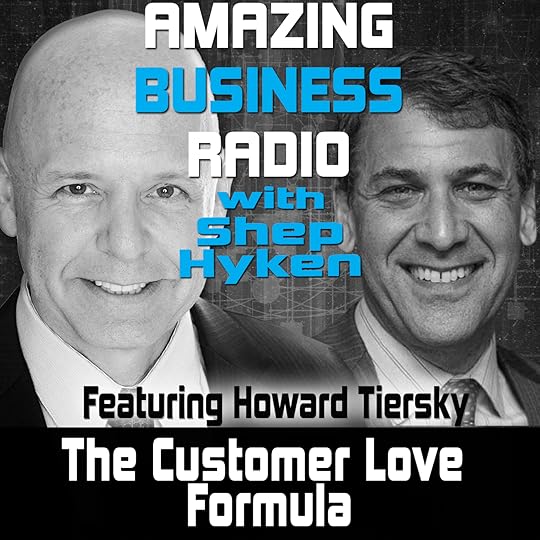 The Customer Love FormulaHow to Make Your Customers Love Doing Business with You
The Customer Love FormulaHow to Make Your Customers Love Doing Business with YouShep Hyken interviews Howard Tiersky, Wall Street Journal bestselling author of Winning Digital Customers: The Antidote to Irrelevance. They discuss how valuable customer love is to succeed in an ever-changing world of business.







 Top Takeaways:The reality of today’s digital world is that the transformation of technology is never done. Therefore, all companies need to continuously change and pivot to keep up with their customers’ expectations and rest of the business world.A lot of companies may have an intuitive belief of where their customers are in terms of their needs, expectations, and pain points. Unfortunately, they don’t do the necessary research to keep their finger on the pulse of where their customer is right now.Customer behavior is vital in keeping your business profitable – and there are more customer behaviors besides buying and coming back to buy again.Many studies have revealed that while the emotional and rational side of a person plays into purchase decisions, the emotional side tends to be more powerful in purchasing behavior.Customer love is the feeling that you can count on a brand to give you what you need and more, along with a feeling of alignment or spiritual connection. The companies that inspire a lot of customer love have better business metrics overall.The formula for achieving customer love is spilt into three parts: meeting customer needs, periodically delighting your customers, and standing for something that resonates with your customers’ values.Brands with high customer love consistently have more growth, profit, and valuation.There is a proven transformation process companies can use to improve their fulfillment of the ‘love formula’:Step 1. Understand Your CustomerStep 2. Map the Customer JourneyStep 3. Build the FutureStep 4. Optimize the Short TermStep 5. Lead the ChangeQuotes:
Top Takeaways:The reality of today’s digital world is that the transformation of technology is never done. Therefore, all companies need to continuously change and pivot to keep up with their customers’ expectations and rest of the business world.A lot of companies may have an intuitive belief of where their customers are in terms of their needs, expectations, and pain points. Unfortunately, they don’t do the necessary research to keep their finger on the pulse of where their customer is right now.Customer behavior is vital in keeping your business profitable – and there are more customer behaviors besides buying and coming back to buy again.Many studies have revealed that while the emotional and rational side of a person plays into purchase decisions, the emotional side tends to be more powerful in purchasing behavior.Customer love is the feeling that you can count on a brand to give you what you need and more, along with a feeling of alignment or spiritual connection. The companies that inspire a lot of customer love have better business metrics overall.The formula for achieving customer love is spilt into three parts: meeting customer needs, periodically delighting your customers, and standing for something that resonates with your customers’ values.Brands with high customer love consistently have more growth, profit, and valuation.There is a proven transformation process companies can use to improve their fulfillment of the ‘love formula’:Step 1. Understand Your CustomerStep 2. Map the Customer JourneyStep 3. Build the FutureStep 4. Optimize the Short TermStep 5. Lead the ChangeQuotes:“In this time of rapid change, you really don’t have a choice if you want your business to remain relevant and successful. You must keep changing with the times.”
“Remember that in the end, companies don’t buy anything. Only people buy things. There’s no company behavior.”
“To achieve customer love, you must consistently meet the needs of your customers, occasionally delight them in unexpected ways, and align with their values.”
About:Howard Tiersky is the Wall Street Journal bestselling author of Winning Digital Customers: The Antidote to Irrelevance. Howard is the founder of two companies that enable large brands to win in the digital world: FROM, The Digital Transformation Agency and Innovation Loft.
Shep Hyken is a customer service and experience expert, New York Times bestselling author, award-winning keynote speaker, and your host of Amazing Business Radio.
This episode of Amazing Business Radio with Shep Hyken answers the following questions … and more:
What is customer love?What are the similarities between B2B and B2C companies?How can companies stay relevant in today’s digital world?How do you make customers love doing business with you?What is the difference between customer love and customer loyalty?The post Amazing Business Radio: Howard Tiersky appeared first on Shep Hyken.
March 22, 2021
5 Top Customer Service Articles For the Week of March 22, 2021
Each week I read a number of customer service and customer experience articles from various resources. Here are my top five picks from last week. I have added my comment about each article and would like to hear what you think too.
Forget Customer Experience. Forget Employee Experience. Enter Total Experience by David Roe
(CMSWire) ECM and content services, while related, are not the same. Such is the case with a term Gartner introduced last year called multiexperience.
My Comment: The title of this article was enough to intrigue me to want to read it. CX (Customer Experience) has been around for years. In the past few years, we’ve seen the concept of EX (Employee Experience) being brought into the business world. Still, it’s not as common as it could and should be. And, now we have TX (Total Experience). When you put it all together, that’s what you get. When it comes to the experience, focus on the inside and outside of your company.
The Benefits of Empowering Your Customer Service Team by Marisa Sanfilippo
(Business News Daily) Making sure your customer service team feels empowered to get their work done is critical to their success.
My Comment: Here is a good reminder about the concept of empowerment. If you hire the right people and train them well, then you should eventually feel comfortable about them making the right decisions. The key behind empowerment is to let it happen. Give people a chance and they may surprise you with how good they really are.
Guest Post: Want To Improve Your Customer Service? Start With Being More Consistent by Dan Gingiss
(StellaConnect) Consistency is one of the hallmarks of customer service and customer experience.
My Comment: Consistency is not just a word… It’s a concept and a strategy. I’ve been preaching the concept of consistency since I did my first speech back in the 1980’s. People want the product to work every time. They want the experience to be the same, every time. They want the employees from the company they interact with to be helpful, knowledgeable and competent, every time. Consistency creates confidence, which turns into repeat business – and maybe even loyalty. That’s my take, now learn from Dan Gingiss.
4 Best practices for leaders to add to their customer experience (CX) strategy in 2021 by Adrian Swinscoe
(Adrianne Swinscoe) I’ve been talking about four best practices or objectives that the companies that lead their fields on customer experience have in common.
My Comment: Thank you, Adrian Swinscoe, for reminding us of these four best practices. Leaders only get smarter when they (1) ask the right questions, (2) use data to understand their customers, (3) understand the basics of customer service, and (4) understand the way customers think.
4 Ways to Deliver a Transcendent Customer Experience to Employees by Ram Chakravarti
(CIO) For people slowly returning to the workforce, matters of the employee experience (EX) are moving front of mind.
My Comment: We started this Top Five Roundup with the concept of TX (Total Experience), which combines the customer and employee experience. However, for there to be a good TX – and even a good CX – you must focus on employees. Here are four ways to better engage with your employees, so they will be motivated to better engage with your customers.
BONUSESExpert Casino Marketing Advice by Julia Carcamo
(J Carcamo & Associates) One of our Casino Marketing Boot Camp goals has been to reach beyond the casino industry for new ideas that will help us become better marketers and connect with our stakeholders. I thought I’d ask some of the marketing experts I have come to know for their casino marketing advice and tips.
My Comment: My friend Julia Carcamo is an expert in casino marketing. She reached out to for CX experts and asked for their input. Even though this is an article about casinos, we can all learn from the advice. (Thank you, Julia, for including my ideas.)
20 Best Customer Experience Quotes by Niyathi Rao
(SmartKarrot) Customer experience quotes that will inspire you to improve customer experience strategies and promote customer-led growth.
My Comment: I love quotes, and our friends at SmartKarret have compiled 20 of them for us. I’m honored to be included with some very notable business celebrities.
Shep Hyken is a customer service expert, professional speaker and New York Times bestselling business author. For information on The Customer Focus customer service training programs go to www.TheCustomerFocus.com. Follow on Twitter: @Hyken
customer service training programs go to www.TheCustomerFocus.com. Follow on Twitter: @Hyken
The post 5 Top Customer Service Articles For the Week of March 22, 2021 appeared first on Shep Hyken.





